The Gift of South Dakota
Subscriptions to South Dakota Magazine make great gifts!
Subscribe today — 1 year (6 issues) is just $29!
The Buzz from Prairie Moon Farm
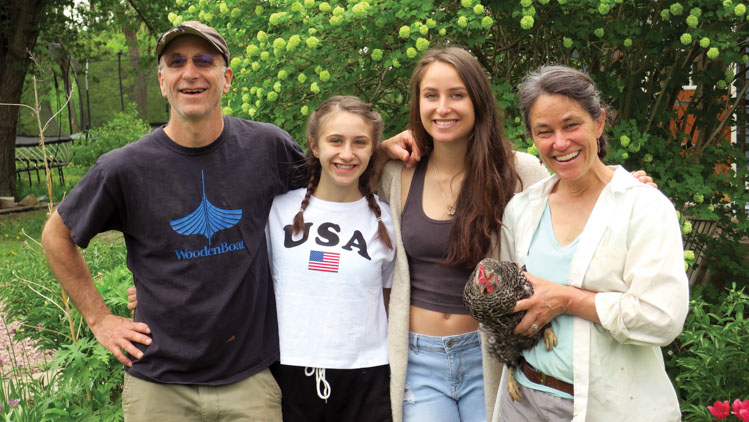 |
| The Freemans of Prairie Moon Farm include (from left) Harry, Willa, Elena, Grace and Harrison (not pictured). |
Grace Freeman might be one of the calmest people we’ve ever met. Nothing seems to faze the Clay County beekeeper. When a mouse jumps out of the brome at her, she doesn’t blink. If she’s posing for a picture with a chicken and the bird leaves a deposit on her shirt, it doesn’t erase the friendly smile from her face. Put her next to a hive with thousands of stinging insects, and she’s happy as can be.
A Cincinnati native, Freeman fell in love with beekeeping in 1985 through a work-study job with an entomologist at the University of Montana. “We would go and collect bees and study them to see if they had picked up pollutants,” she says. When she and her husband, Harry, moved to Madison, Wisconsin for grad school, Freeman worked for a large-scale beekeeper, managing up to 1,000 colonies. After Harry took a job in the psychology department of the University of South Dakota, the couple settled in a farmhouse on Frog Creek Road, where they have lived for 21 years with their children, Elena, Willa and Harrison.
The Freemans’ home, Prairie Moon Farm, is a back-to-the-lander’s Eden. Chickens and guinea fowl roam freely, a trio of penned-up rescue llamas provide manure to fertilize her garden and scare away deer, and a friendly dog named Saige welcomes visitors. There’s a shed full of kayaks for paddles on the Missouri, a greenhouse and a small but fragrant structure where Freeman creates tinctures and blends herbs for teas she sells at the Vermillion Farmers’ Market.
Freeman’s hives are in a little glade a short walk away from the buildings, past a pond and a stand of honeysuckle bushes. She puts on her veiled beekeeper’s hat and sets the smoker filled with smoldering brown paper scraps and wood chips on the ground. The smoke fools the bees into letting their guard down, making it less likely they will sting. “They think there’s a fire and they have to travel,” Freeman says. “They fill up on honey, and get so full that their stinger goes down.”
When working with bees, Freeman recommends wearing white or light-colored clothes. “Bees get angry if you wear dark colors,” she says. “It reminds them of bears.” And be sure to tuck in your clothes. “You don’t want them crawling in your shirt,” she tells us. Some beekeepers wear a protective suit and gloves, but after decades of working with bees, Freeman has developed a more casual style — a long-sleeved white shirt over a tank top and shorts.
Freeman uses Langstroth hives, which consist of a stack of wooden boxes, each of which contains hanging wooden frames upon which the bees build their comb, raise young and store honey. The supers, shallower boxes at the top of the hive, will hold harvestable honey. The queen, the brood and the colony’s food storage all go in the deeper, lower boxes. A metal rack called a queen excluder separates the two portions of the hive. The rack’s slats are big enough to allow worker bees to pass between sections, but keep the larger queen down in the brood cells where she belongs. After all, no one wants bee eggs mixed in with their honey.
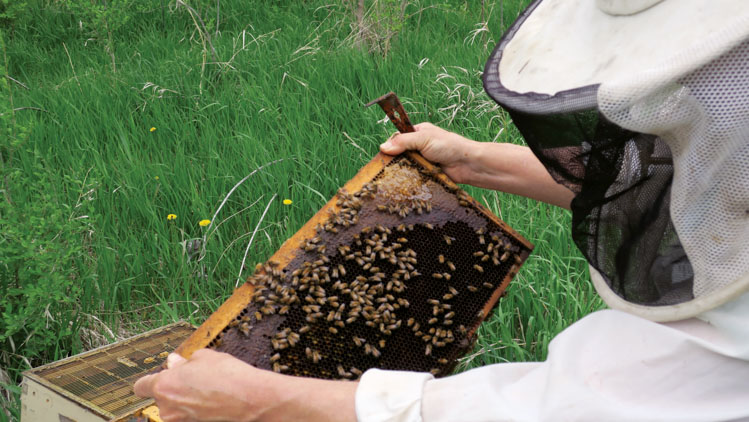 |
| Freeman inspects a frame from one of the hive's supers. She harvests honey in late summer. |
The hive’s lid is stuck on tightly with propolis, a gluey yellowish-brown substance that bees make from tree resins and beeswax. Freeman uses a mini crowbar called a hive tool to break through the glue and help manipulate frames as she checks on the bees and their activities.
The queen is the only female in the hive that mates and lays the fertilized eggs that develop into worker bees, so Freeman looks for fresh eggs to make sure the queen bee is doing her job. “Eggs change every day,” she says. “If you can see the one-day-old eggs, then you know you have a viable queen. Even if it’s a two-day-old egg, something could’ve happened to her.”
Bee society is fascinatingly complex and overwhelmingly female. The only males are the drones. They have no stingers and do no gathering — their only job is to be available to mate with a virgin queen bee. After mating, they die. The worker bees, all female, cycle through a series of roles — foraging, building, housekeeping, childcare, attending the queen, guarding the hive. There are even mortuary bees, who haul the colony’s dead away from the hive. With so much to do, it’s no surprise that the life of a worker bee is short. During the busy spring and summer seasons, they might live a brief four to six weeks.
Under most conditions, bees manage themselves, but there are critical points during the year when a beekeeper should pay attention. In spring, Freeman helps the bees get ready for the season, making sure that they have food to last them until the flowers really start blooming and that there’s plenty of space to make new honey. In June, when the clover blooms, she watches for signs of swarming. “If you haven’t provided them with enough room, then they’ll divide,” she says. The bees will create a second queen and fly off in search of a new hive, leaving the old queen with a few guards for protection. A divided colony means less honey, so Freeman destroys any potential new queen cells she spots.
Once the fear of swarming is over, Freeman’s bee work slows down a bit. When the bees fill up the existing frames, she adds supers. Honey is harvested in August. “Then they have time in the fall to put on enough winter weight so you don’t have to feed them so much sugar water,” Freeman says. After that, it’s time to winterize the hive.
Winter and early spring are tricky times for beekeepers. Freeman lost one of her two colonies last spring due to uncertain weather. “I can get them through until March and then the temperature warms up and they start moving more — they get excited,” she says. “Moisture builds up, the temperature drops and they freeze. I have really been trying to figure out how to ventilate and still keep them warm enough.”
In a good year, Freeman harvests 50 to 100 pounds of honey per hive, selling it at the Vermillion Farmers’ Market along with garden plants, culinary and medicinal herbs, teas, tinctures, salves and lip balm made from her own beeswax. When she’s not gardening, marketing or beekeeping, she works as a registered nurse. How does she juggle it all? “Oh, I’m not very good at it,” Freeman says. “We’re always busy. My summers are just nuts.”
But no matter how crazy life gets, the bustle of the hive serves as an oasis. Bee stings hold no fear, and the sounds of the hive have a calming, meditative effect. “For me, it’s very relaxing to have that noise going all around you, all the bees flying,” she says. “It’s very loud, but you’re focusing so hard on looking for those eggs that you don’t even hear them, and it gets very peaceful.”
Meloamakárona (Honey-dipped Cookies)
Honey is a major component of Greek cooking. Freeman’s husband, Harry, who is half-Greek, makes baklava and meloamakárona, or honey-dipped cookies, using recipes found in a community cookbook from his mother’s hometown, Seattle.
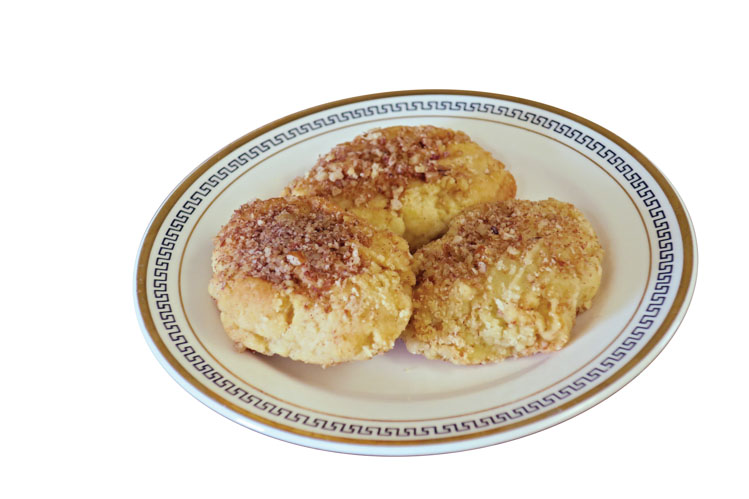 |
Cookies
1 cup butter, softened
1 cup salad oil
6 tablespoons sugar
1/2 cup plus 1 tablespoon fresh
orange juice (divided)
Grated peel of one orange
2 eggs
1/4 teaspoon baking soda
3 teaspoons baking powder
6 to 6 1/2 cups sifted flour
Nut Topping
1/2 cup very finely chopped nuts
1/4 teaspoon cinnamon
1/8 teaspoon nutmeg
1/8 teaspoon cloves
Honey Syrup
2 cups honey
1/2 cup water
In large bowl of electric mixer, beat butter until light and fluffy. Add oil slowly and continue beating for 10 minutes. Gradually add sugar, 1/2 cup orange juice and peel. Add eggs, one at a time, and beat an additional 5 minutes.
Combine 1 tablespoon orange juice and baking soda; add to butter-oil mixture. Add baking powder and enough flour to make a soft dough. Remove beaters; knead slightly to make a dough that does not stick to hands, adding more flour if necessary.
Roll a heaping teaspoonful of dough into an oval-shaped cookie, tapering the ends slightly. Press the melomakárona lengthwise with fork tines to make indentations to hold the nut topping. Bake at 375 degrees for 20-25 minutes. Remove cookies from baking sheet and cool on wire racks.
Mix ingredients for nut topping and set aside.
When cookies have cooled, bring honey and water to a boil. Dip melomakárona into honey syrup, being certain to thoroughly soak the cookies. Sprinkle tops with nut topping.
From Greek Cooking in an American Kitchen (Makes about 5 dozen)
Editor’s Note: This story is revised from the September/October 2018 issue of South Dakota Magazine. To order a copy or to subscribe, call (800) 456-5117.


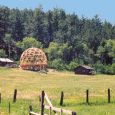
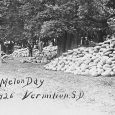






Comments